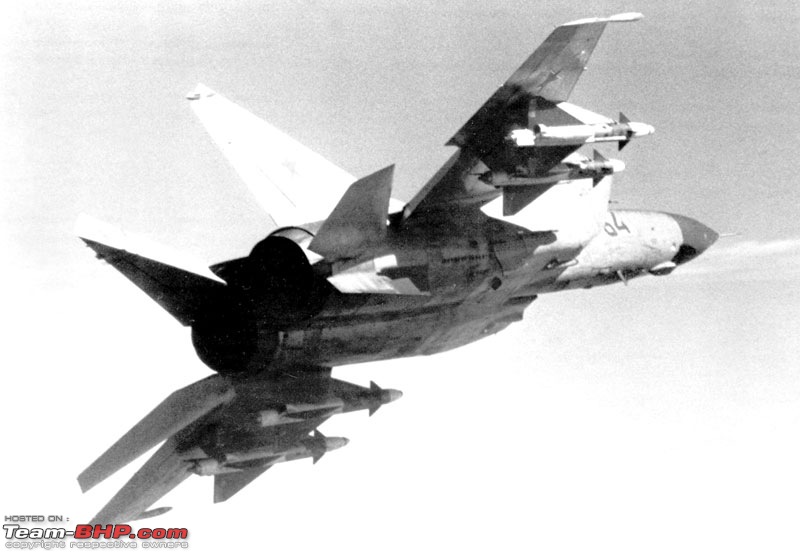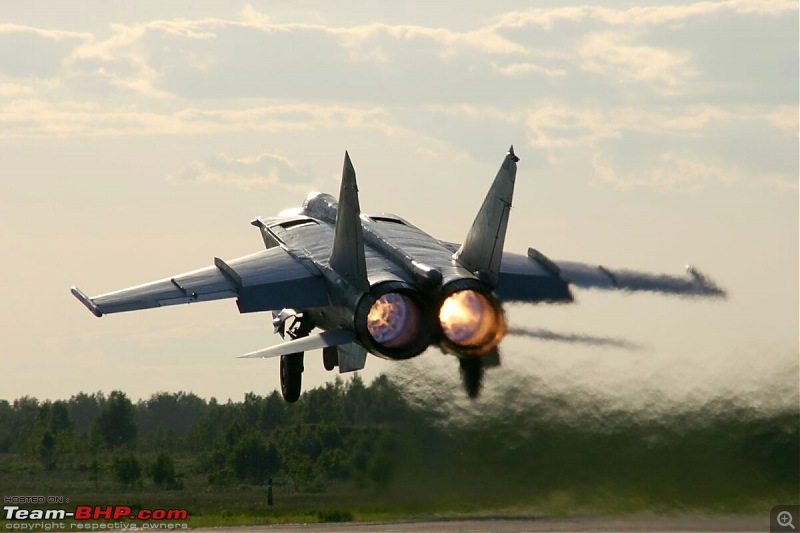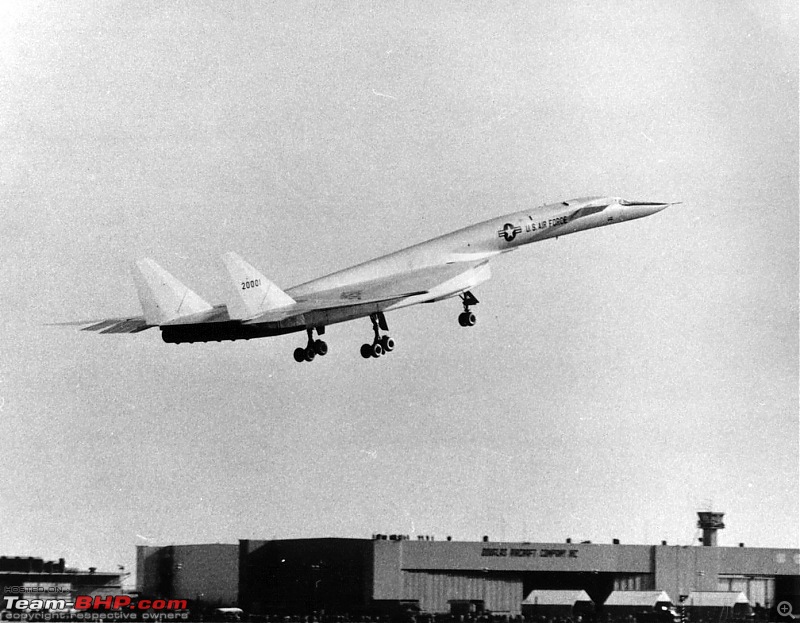| Distinguished - BHPian
Join Date: Aug 2014 Location: Delhi-NCR
Posts: 4,325
Thanked: 72,162 Times
| Re: Indian Aviation: MiG-25 Foxbat in the Indian Air Force
https://hushkit.net/2018/12/12/lonel...-foxbat-pilot/
Execerpts from article by www.hushkit.net
Thanks to BHPian Stewie for pointing this out. Parts of the article, which is an interview with a retired IAF Air Marshall are quoted below. Quote: What were your first impressions of flying the MiG-25R ?
“A 20-ton aircraft that carries 20 tons of fuel, flies in the stratosphere, cruises at Mach 2.5 in minimum afterburner and exceeds Mach 3.0 with ease when required, what can one say ? It was an awesome aeroplane. The fact that the ventral fuel tank was one MiG-23 (equivalent in fuel) under the belly, speaks for itself.”
Which words best describe the MiG-25 ?
“Catch me if you can”
What is the cockpit like and how pilot-friendly is it ?
“Most Russian aircraft cockpits evoke a feeling of comfort and familiarity to a pilot who has flown Russian aircraft before. Coming from the MiG-21 to the MiG-25R was an easy transition. As one of our Air Chief’s remarked when the aircraft was demonstrated to him and he was stepping into the cockpit, “This is rather familiar. And dammit, it even smells the same!” The cockpit was a little more spacious than the MiG-21, thankfully so, because we operated wearing the pressure suit (which, incidentally, was the same as that worn by Yuri Gagarin – so much for Russian sustainability and dependability).
What can you say about the performance of the MiG-25 ?
“It was a beast with immense power. It has been described by some as ‘an engine with place for a pilot and some avionics’. The Tumansky R-15B engines each provided more than 10 tons of thrust to produce the desired performance. In almost all the other aircraft I have flown, a regular climb was executed at constant TAS (True Air Speed, the speed of the aircraft relative to the airmass in which it is flying) with a progressive reduction of IAS as the altitude increased. The Foxbat climbs at constant IAS with an increasing TAS, crossing abeam the take-off dumbbell (if a reciprocal turn were to be executed after take-off), at 30,000 ft and increasing! She would be crossing 20km (65,000 ft) in 6.5 minutes from wheels-roll, at a rate of climb (ROC) of 100 m/sec (almost 20,000 ft/min) ‘like a bat out of hell’, if you did not come back from the Max afterburner regime – In comparison, the ROC of a MiG-21 was 110 m/sec at sea-level. Now, that is sheer performance. Cruising at 20+ kms with minimum afterburner (which, incidentally, provided best specific fuel consumption) she could execute a 45-50 deg bank turn with just a wee bit of additional power. There was no loss of height. Her systems and auto-pilot were coupled to provide an optimised “Little m=1” (remember the formula for maximum range ?). So, as the fuel depleted she would keep climbing (cruise climb) and a mission commenced at (say) 19.5 kms altitude would terminate around 22 kms with no change of throttle position. The climb was so gradual over the period of time and distance that it did not affect the photography.”
What was the pilot workload ?
“With virtually a first generation inertial navigation system (coupled with the ground beacon RSBN), one could engage the auto-pilot at 50m (165 ft) after take-off and take your hands off the control column. The Foxbat would execute the complete mission, photography included, and return to base (or programmed airfield) descending to a height of 50m when the pilot needed to take control and flare out for a landing. All that the pilot was required to do through the entire mission was manipulate the throttle – From max afterburner at take-off, to min afterburner at about 60,000 ft, to idle throttle setting approximately 350 Kms from landing base (the MiG-25 would glide the distance), to 75% RPM on top of approach to landing. That’s it !”
Were you detectable by radar ? Were you susceptible to interception ?
“Certainly we were detectable by radar, provided you were expecting us. The Foxbat operated covertly, seen just as a blip on the radar amongst other flying aircraft, but one blip would suddenly disappear. In normal ground radar settings the Foxbat generally operates at the highest fringes of the radar lobe, with the ingress and egress (through the radar lobe) often allowing one or two blips for the radar controller to perceive. Low transition times (because of the high speed) did not provide adequate reaction time to scramble fighters; and other than a pure head-on interception with look-up / shoot-up capability (from, say, 40,000 ft), the Foxbat could survive any fighter interception.”
What were the limitations of the aircraft ?
“The fuel quantity, I guess. The engines were gas guzzlers and 20 tons of fuel (including the ventral tank and fuel in the vertical fins) was just adequate. In the regional perspective of India and its neighbours it would suffice but we always returned for landing with 200-400 kg of fuel remainder (200-250 kgs was the fuel required to execute one circuit and landing). We operated on the fringe. The runway had to be kept clear at landing base (no other flying permitted for fear of runway blockage) once the MiG-25 commenced his descent. We needed to give only three R/T calls – one for take-off, one for commencing descent and one for landing (in operational missions just two). There was no need to give any other R/T calls because you operated unhindered in the stratosphere
What does operating in the stratosphere feel like?
“The subtle change in the colour of the sky starts around 16 kms (50,000 ft), I guess, as the suspended particles which reflect / refract the sunlight start getting dissipated. The sky turns a distinct grey as you cross 20 Kms (65,000 ft) and continues getting darker as you transcend into those dizzying altitudes of 90,000 ft and 100,000 ft. You fly with cockpit lighting ‘ON’ (as for night flying). It is a little eerie, one must admit. Not natural. The earth is round, a fact we could confirm (!) because you can see the curvature of the earth very clearly from those altitudes. The sun, moon, stars and the illuminated ground below, are all visible at the same time. A glorious feeling.”
What were your biggest fears in flying the MiG-25 or were there none?
“When you are flying a virtual fuel tank, the biggest fear is the illumination of the “Fire” warning lamp. This was more so at operating altitudes in the stratosphere. The ejection seat in the MiG-25 was the same as that in the later models of the MiG-21 and MiG-23. The ejection seat had two settings (3 Kms / 10,000 ft and 6 Kms / 20,000 ft), to be set depending upon the terrain one was operating over. We set ours to 6 Kms. But operating at (say) 20-22 Kms altitude, where the ambient temperatures are around minus 85 deg C, an ejection meant a free-fall of 15 Kms (50,000 ft) before the seat separated and activated the parachute. Would you hit terminal velocity ? I guess you would. It was not a happy thought.
| 
Soviet MiG-25 with 4 Bisnovat R-60 air-to-air missiles 
Outline of the IAF MiG-25R Recce version. A part of our proud aviation heritage. 
With full afterburners 20,000 kgf of thrust. Today this awe inspiring and romantic aircraft has flown over the horizon. With changing technology & tactics it is unlikely the IAF, or any Air Force, will field a Mach 3.0 fighter in the forseeable future. |

 (3)
Thanks
(3)
Thanks


 (1)
Thanks
(1)
Thanks
 (1)
Thanks
(1)
Thanks

 (2)
Thanks
(2)
Thanks

 (3)
Thanks
(3)
Thanks

 (15)
Thanks
(15)
Thanks
 (4)
Thanks
(4)
Thanks

 (2)
Thanks
(2)
Thanks
 (4)
Thanks
(4)
Thanks

 (3)
Thanks
(3)
Thanks

 (1)
Thanks
(1)
Thanks
 (1)
Thanks
(1)
Thanks












 You are right that the Valkyrie spurred the Soviets on to develop the Sukhoi T-4 at least to the prototype stage and it was similar in wing configuration to the XB-70 Valkyrie. The T-4 was a direct response to match the Valkyrie. Not for the first time was a weapon attractive simply because the other side had it (or you thought they had it). You are right in the end the ICBM prevailed. In the world of bombers the Americans went with the Rockwell B-1 and the Russians with the Tupolev Tu-22M
You are right that the Valkyrie spurred the Soviets on to develop the Sukhoi T-4 at least to the prototype stage and it was similar in wing configuration to the XB-70 Valkyrie. The T-4 was a direct response to match the Valkyrie. Not for the first time was a weapon attractive simply because the other side had it (or you thought they had it). You are right in the end the ICBM prevailed. In the world of bombers the Americans went with the Rockwell B-1 and the Russians with the Tupolev Tu-22M